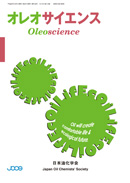
- |<
- <
- 1
- >
- >|
-
[in Japanese]2024 Volume 24 Issue 11 Pages 468
Published: 2024
Released on J-STAGE: November 06, 2024
JOURNAL FREE ACCESSDownload PDF (502K)
-
Toshiaki TAIRA2024 Volume 24 Issue 11 Pages 469-474
Published: 2024
Released on J-STAGE: November 06, 2024
JOURNAL FREE ACCESSThe cyclic heptapeptide surfactin is a promising biosurfactant, which is produced from renewable resources by Bacillus subtilis. The present review mainly focuses on the unusual structure of surfactin. It highlights various functions and sustainability of surfactin that are closely related to the cyclic peptide moiety.
 graphical abstract Fullsize ImageView full abstractDownload PDF (2037K)
graphical abstract Fullsize ImageView full abstractDownload PDF (2037K) -
Jikun MENG, Kazunobu TOSHIMA, Daisuke TAKAHASHI2024 Volume 24 Issue 11 Pages 475-481
Published: 2024
Released on J-STAGE: November 06, 2024
JOURNAL FREE ACCESSMannosylerythritol lipids (MELs) are a class of amphipathic molecules with a hydrophilic 4-O-β-d-mannopyranosyl-erythritol skeleton and two hydrophobic fatty acyl chains. So far, our group has accomplished the systematic and stereoselective total synthesis of 20 kinds of S-MEL-A-D (C6, C8, C10, C12, C14) with different fatty acid chain lengths and different patterns of Ac groups at C4’ and C6’ of the mannose moiety and a structure-activity relationship (SAR) study of the recovery effects on damaged skin cells was performed. As a result, it was found that S-MELs with C10 fatty chain length showed high recovery effects on damaged skin cells. Here, to create candidate molecules for new cosmeceuticals, we designed and synthesized four kinds of MEL analogues, R-MEL-A, S-mannosylthreitol lipid (MTL)-A, R-MTL-A, and α-S-MEL-A, using our previously reported boron-mediated aglycon delivery (BMAD) method and a neighboring group-assisted glycosylation method. Among them, R-MTL-A showing the highest selective cytotoxicity against human skin squamous carcinoma cells also exhibits an efficient recovery effect on damaged skin cells, indicating that R-MTL-A has potential as a lead compound for new cosmeceuticals.
 graphical abstract Fullsize ImageView full abstractDownload PDF (1700K)
graphical abstract Fullsize ImageView full abstractDownload PDF (1700K) -
Tokuma FUKUOKA, Yosuke KOBAYASHI2024 Volume 24 Issue 11 Pages 483-490
Published: 2024
Released on J-STAGE: November 06, 2024
JOURNAL FREE ACCESSSophorolipids (SLs) are promising glycolipid biosurfactants as they are readily produced and functional. SLs from microorganisms are comprised of mixtures of multiple derivatives that have different structures and properties, including well-known acidic and lactonic SLs (ASLs and LSLs, respectively). Here, we established a method for analyzing all SLs derivatives in the products of Starmerella bombicola, a typical SL-producing yeast. Detailed component analyses of S. bombicola products were carried out by reversed-phase high-performance liquid chromatography and mass spectrometry using methanol as the eluent since it is a good solvent for all SL derivatives. With this approach, we succeeded in accurately quantifying the content of all SL derivatives, and found a variety of novel SL derivatives with structures different from conventional ASLs and LSLs.
 graphical abstract Fullsize ImageView full abstractDownload PDF (1055K)
graphical abstract Fullsize ImageView full abstractDownload PDF (1055K)
- |<
- <
- 1
- >
- >|